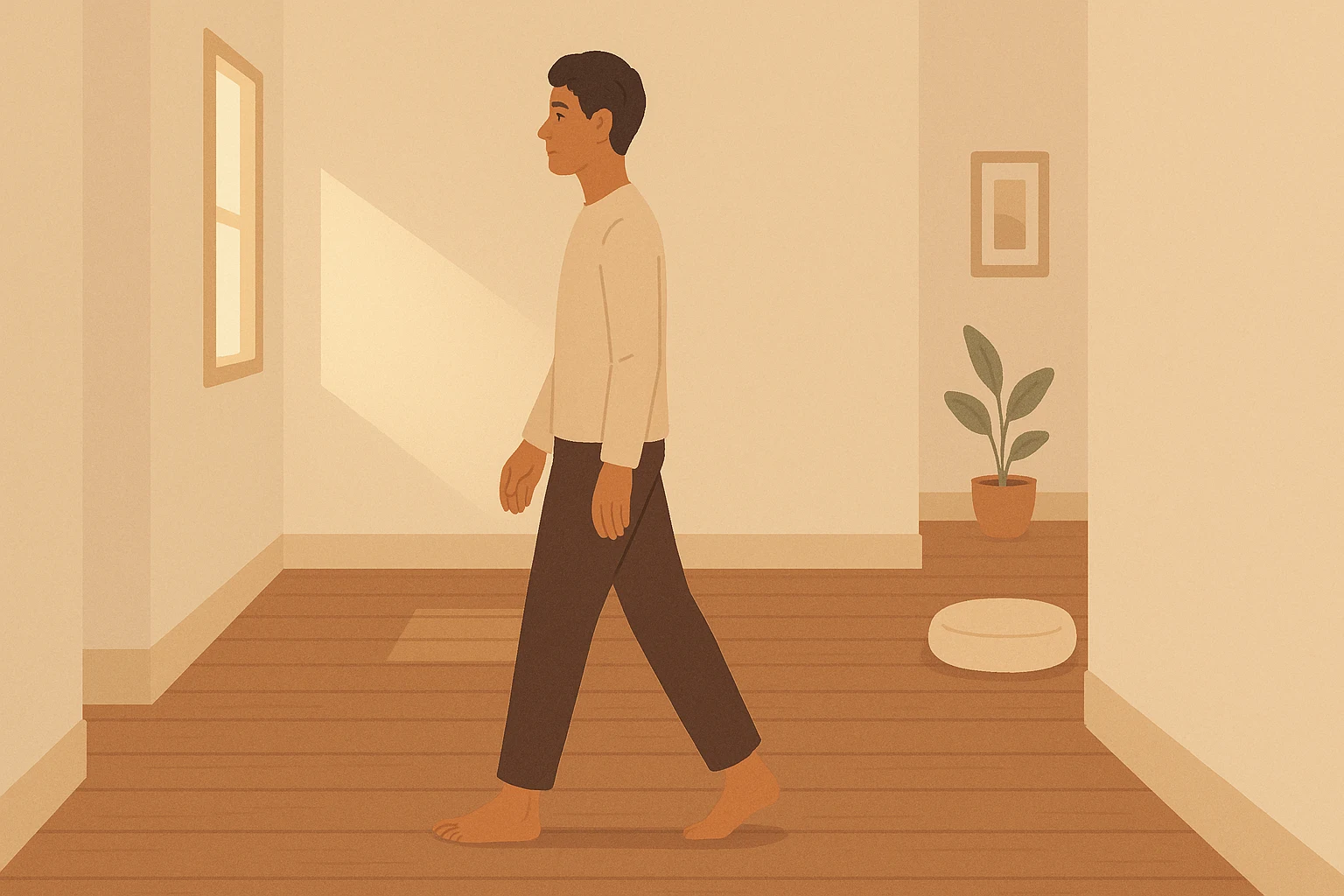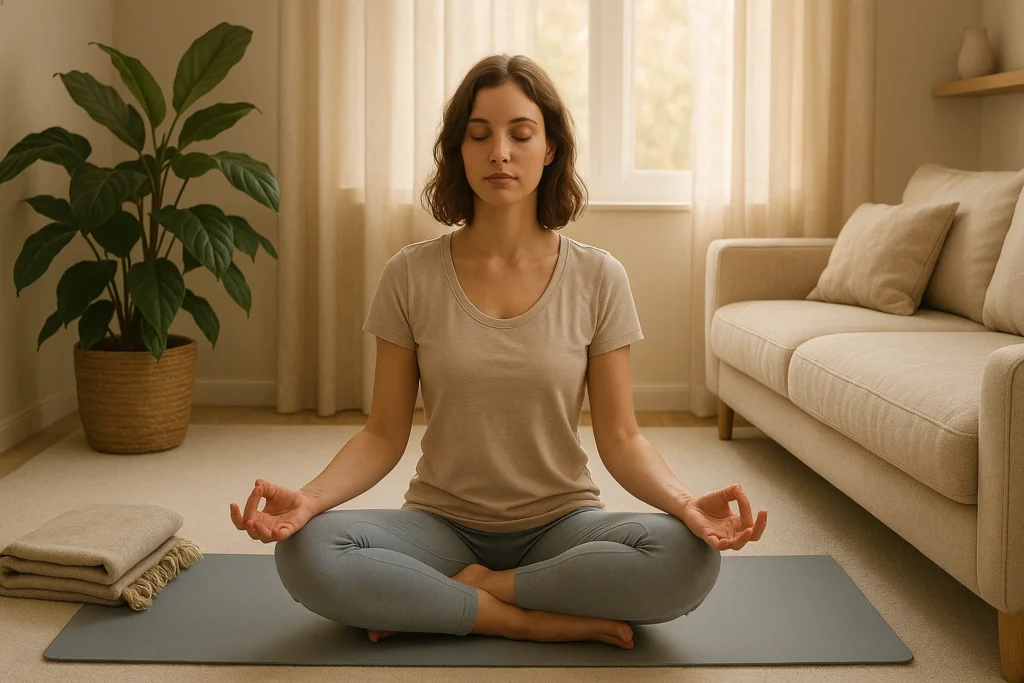
Struggling to sit still but craving some calm? Mindfulness walking meditation blends movement with awareness, offering an active calm that can suit restless minds. Short, focused sessions — even around 10 minutes — may help ease stress and lift mood.
Jane, a busy mom, transformed her daily park stroll into a moment of clarity with this practice. To understand how it fits within a wider approach to reducing stress through mindfulness, explore mindfulness stress relief.
Start Your Mindful Walk Now!Table of Contents
Key Takeaways
- Active Meditation: Mindfulness walking meditation combines movement with focus, ideal for those who find seated meditation tough.
- Simple Yet Powerful: Stay present by noticing your posture, pace, and breath with each step.
- Flexible Practice: Walk mindfully indoors, outdoors, or in public—anywhere works.
- Overcome Distractions: Wandering thoughts are normal; gently refocus to build mindfulness.
- Personalized Guidance: Use our Walking Meditation Starter for tailored scripts.
This post has affiliate links. We may earn a commission. Learn more.
What is Mindfulness Walking Meditation?
This mindful walking practice involves full intention and awareness. As a form of mindful movement, walking meditation channels physical motion into mental stillness. Instead of daydreaming, you focus on each step, your breath, or your surroundings—without judgment.
How Mindfulness Walking Differs from Seated Meditation
Both practices cultivate presence, but they differ significantly:
- Stillness vs. motion: Seated practice asks for stillness (often with eyes closed), while walking turns movement into the meditation itself.
- Accessibility: If you live with anxiety or ADHD, sitting may feel hard; mindful walking gives that energy somewhere gentle to go.
- Grounding: With each step, you feel the ground under you and a clearer sense of being here.
- Fits daily life: You can fold it into a commute or quick errand—no special room required.
- Sensory engagement: Sounds, colors, and textures come forward—you simply notice without judging.
“This can turn a simple stroll into a moment of real presence.”
Walking Meditation Benefits
Walking meditation benefits may include reduced anxiety, deeper focus, and improved emotional regulation — making it a supportive tool for mental well-being. Walking mindfully offers potential benefits, backed by emerging science:
- Grounding: Focusing on your feet roots you in the moment, calming an overactive mind. For example, Jane found her morning walks centered her before a hectic day.
- Mood Regulation: Regular practice may help reduce stress and support well-being, complementing other mindfulness techniques for stress. An NCCIH overview notes potential benefits for stress and overall well-being.
- Active Mindfulness: Staying present while moving can enhance focus in daily tasks.
- Better concentration: Each time you notice drifting and return, you train attention—for work, conversations, and everything in between.
- Physical health: Regular walking supports your heart and helps maintain muscle tone—pairing mental and physical benefits.
- Nature connection: Outdoor walks may deepen your appreciation for nature and lift overall well-being.

How to Practice Mindfulness Walking Meditation (Step-by-Step)
Ready to try? Here’s a simple way to begin. There’s no perfect way—just steady attention.
1. Prepare for your practice
Pick a quiet spot (park or hallway). Wear comfortable shoes, silence notifications, and set an intention: “I’ll be present with each step.”
2. Adopt a mindful posture
Stand tall, let your shoulders drop, and soften your gaze 6–10 feet ahead to stay oriented and relaxed.
3. Set a deliberate pace
Start slowly so you can feel each step—lift, move, place. As it settles, let a natural rhythm emerge.
4. Sync with your breath
Let your breath be easy. If it helps, match two steps per inhale and two per exhale—only if it feels natural.
5. Choose your focus anchor
Your anchor keeps you present. Try one of these:
Feet sensations
Feel the sequence: lift, swing, place. Notice heel strike and weight shift. Gently label it: “Lift, move, place.”
Body movements
Notice your arms, hips, and the brush of fabric. Stay with sensation rather than analyzing it.
Surrounding sounds
Hear birds, traffic, or footsteps without adding a story. A quiet label—“sound, sound”—can help.
Visual cues
Let colors and shapes register, then return to your feet if the mind starts chasing details.
6. Expand Your Awareness
Widen your focus to sounds, sights, or smells. However, return to your anchor (e.g., feet) if your mind drifts. Observe without judgment.
7. Refocus When Distracted
Your mind will wander—it’s normal! Acknowledge, “Thinking,” and refocus on your anchor. Each return builds mindfulness.
8. End with intention
Ease your pace, pause, and take a fuller breath. Notice what feels steady and bring that with you.
Outdoor Mindfulness: Best Places to Practice Walking Meditation
You can do this almost anywhere. Here’s how to make different settings work for you.
Outdoor settings: nature’s embrace
Practicing outdoor mindfulness can heighten your senses and help you feel grounded. Parks and trails offer a lot to notice—the crunch of leaves, the shift of light, the breeze on your skin.
A backyard works too—quiet and close. Change your route now and then to keep it fresh, and check the forecast before you head out.
Indoor settings: controlled calm
A hallway or small room offers privacy. With fewer stimuli, lean into foot sensations. A treadmill can work—keep the pace easy and stay with the rhythm.
Public spaces: mindful amid bustle
Try it on a commute or quick errand. Keep a natural pace, notice the soundscape, and come back to your feet when attention scatters. It can be a gentle way to find calm.
| Setting | Best For | Considerations | Tips |
|---|---|---|---|
| Outdoor | Nature connection, sensory input | Weather, crowds | Focus on natural sounds, breeze, or textures |
| Indoor | Privacy, bad weather | Limited space | Emphasize foot sensations, use a timer |
| Public | Daily integration | Distractions, self-consciousness | Maintain natural pace, notice sounds without judgment |

Overcoming Challenges in Mindful Walking
Challenges will pop up. Here’s how to keep going.
Handling a Wandering Mind
The mind wanders—that’s normal. When you notice, mark it with a gentle “thinking,” then return to your feet or breath. Every return builds the skill.
Managing Boredom or Impatience
If slow walking feels dull, try five minutes at first. Switch anchors (feet, then sounds) to keep it fresh.
Easing Physical Discomfort
Keep your posture easy rather than rigid. If something aches, slow down or pause. Let comfort set the pace.
Navigating Distractions
Noise will tug at attention. Name it—“sound”—and come back to your anchor. Treat it as part of the walk, not a problem.
Building Consistency
Begin with 5–10 minutes a day. Put it on the calendar like any other walk. The interactive guide below can help.
Your Personalized Mindful Walking Guide
Use the tool below to create a walking meditation script that fits your space and time.
Walking Meditation Starter 🚶♀️
Select your walking environment and duration to get a personalized guide.
Frequently Asked Questions About Mindful Walking
Conclusion: Step into Presence with Mindful Walking
This turns a simple stroll into a steady mindfulness practice. Whether in a park or a busy street, each step can bring calm and clarity. Take one mindful step today—walking meditation benefits often build over time.


